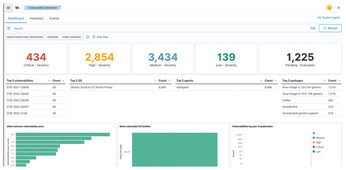Integrated security with Wazuh
The Watcher

© Lead Image © arasdubov, 123RF.com
This versatile security app checks for vulnerabilities, watches logs, and acts as a single interface for other tools.
Cyberattacks have not lost their power. Many companies and individuals are at risk from various types of calculated attacks. Education and user awareness are very important for combating the danger of cyberattacks. Unfortunately, sometimes sysadmins don't find the necessary information in time because the techniques for breaking through security are constantly changing. One of the best practices is to install a security system that will collect all information about computers and inform the security team about threats. For many users, Wazuh [1] might be the answer.
Wazuh is a free and open source security platform that provides unified XDR and SIEM protection for endpoints and cloud workloads. Wazuh components abide by the GNU General Public License version 2 and the Apache License Version 2.0. The Wazuh agent is a single and lightweight monitoring tool. You can deploy the agent on laptops, desktops, servers, cloud instances, containers, or virtual machines. You can also use the agent to obtain information about vulnerabilities.
Wazuh can detect malware threats, identify vulnerabilities, monitor file integrity, and display information on system inventory. Another important benefit of Wazuh is that it is easy to integrate with other tools.
To detect vulnerabilities, the Wazuh agents collect a list of installed applications from monitored endpoints and send it periodically to the Wazuh server. Within the Wazuh server, the Vulnerability Detection module correlates the software inventory data with vulnerability content documents to detect vulnerable software on the monitored endpoint. The Vulnerability Detection module generates alerts when it detects new vulnerabilities or when a vulnerability is fixed due to a package update, removal, or system upgrade. The alerts mean you do not have to monitor the console and check the scan results every day.
What to Do with Wazuh
Wazuh (Figure 1) is a versatile security tool with a number of useful capabilities. The FIN module performs periodic file scans for integrity violations. FIN scans specific files and directories in real time. It is important to note that this is a fully configurable functionality, which means that the administrator can set specific paths for scanning. The FIN module searches for file modifications by comparing the checksums of previously scanned files. This is possible because the data on the previous scan is stored in the local FIN database.

The FIN module itself is not able to indicate whether a file is malicious; it merely informs the user about possible errors related to the integrity of the file. You can configure FIN to work with other external platforms, such as VirusTotal. Wazuh is also able to detect rootkits using the built-in Rootcheck module. Rootcheck monitors endpoints and alerts you if it detects anomalies. Detection of these threats is based on signatures. The administrator can update these signatures to detect newly discovered rootkits or Trojans. The last element of detecting malicious files is the Log Collection module, which allows collecting and analyzing data from tools such as Microsoft Defender.
The Vulnerability Detection module helps system administrators manage and patch vulnerabilities (Figure 2). Wazuh works based on data from the following sources:
- Wazuh Vulnerability repository
- Offline local repository

Wazuh will inform you with an alert when a new vulnerability occurs and when it is fixed or removed.
Information about the assets in the infrastructure is very important, for example, for a security analyst who will analyze a security alert. A system inventory helps to maximize visibility and centralize control. Wazuh is able to keep tabs on the inventory because the endpoints send information about it to the server. You can then review this data and use it for further work.
Wazuh can also monitor system calls or commands, and it has an Active Response function that provides visibility of events in real time and automates the entire process.
Wazuh Installation
You can install the Wazuh indexer and Wazuh server on a single host or in cluster configuration. The fastest way to get the central Wazuh components up and running is an all-in-one installation. Start by downloading and running the Wazuh installation assistant:
curl -sO https://packages.wazuh.com/4.10/wazuh-install.sh && sudo bash ./wazuh-install.sh -a
Access the Wazuh web interface with
https://<WAZUH_DASHBOARD_IP_ADDRESS>
Provide your credentials:
Username: admin Password: <ADMIN_PASSWORD> random generated password
To install the agent, add the Wazuh repository to download the official packages. Then install the GPG key:
curl -s https://packages.wazuh.com/ key/GPG-KEY-WAZUH | gpg --no-default-keyring --keyring gnupg-ring:/usr/ share/keyrings/wazuh.gpg --import && chmod 644 /usr/ share/keyrings/wazuh.gpg
Add the repository:
echo "deb [signed-by=/usr/share/ keyrings/wazuh.gpg] https://packages.wazuh.com/4.x/apt/ stable main" | tee -a /etc/apt/sources.list.d/wazuh.list
Update the package information:
apt-get update Install the Wazuh agent: apt-get install wazuh-agent
Enable and start the Wazuh agent service:
systemctl daemon-reload systemctl enable wazuh-agent systemctl start wazuh-agent
Wazuh recommends disabling the Wazuh repository to prevent accidental upgrades. To do so, use the following command:
sed -i "s/^deb/#deb/" /etc/apt/sources.list.d/wazuh.list apt-get update
Or you could also use the following command:
echo "wazuh-agent hold" | dpkg --set-selections
Vulnerability Detection Module
The Vulnerability Detection module is enabled by default. To check and make sure that the module is enabled, open the /var/ossec/etc/ossec.conf file on the Wazuh server. Check for the following settings:
<vulnerability-detection> <enabled>yes</enabled> <index-status>yes</index-status> <feed-update-interval>60m </feed-update-interval> </vulnerability-detection>
Then make sure the indexer connection is properly configured. By default, the indexer settings have one host configured. The host is set to 0.0.0.0. Replace 0.0.0.0 with your Wazuh indexer node IP address or hostname. You can find this value in the Filebeat config file /etc/filebeat/filebeat.yml.
Restart the Wazuh manager:
sudo systemctl restart wazuh-manager
To see a list of active vulnerabilities, go to Vulnerability Detection and select Inventory. You can add filters to search for vulnerabilities on endpoints.
Buy this article as PDF
(incl. VAT)
Buy Linux Magazine
Subscribe to our Linux Newsletters
Find Linux and Open Source Jobs
Subscribe to our ADMIN Newsletters
Support Our Work
Linux Magazine content is made possible with support from readers like you. Please consider contributing when you’ve found an article to be beneficial.

News
-
Zorin OS 18 Hits over a Million Downloads
If you doubt Linux isn't gaining popularity, you only have to look at Zorin OS's download numbers.
-
TUXEDO Computers Scraps Snapdragon X1E-Based Laptop
Due to issues with a Snapdragon CPU, TUXEDO Computers has cancelled its plans to release a laptop based on this elite hardware.
-
Debian Unleashes Debian Libre Live
Debian Libre Live keeps your machine free of proprietary software.
-
Valve Announces Pending Release of Steam Machine
Shout it to the heavens: Steam Machine, powered by Linux, is set to arrive in 2026.
-
Happy Birthday, ADMIN Magazine!
ADMIN is celebrating its 15th anniversary with issue #90.
-
Another Linux Malware Discovered
Russian hackers use Hyper-V to hide malware within Linux virtual machines.
-
TUXEDO Computers Announces a New InfinityBook
TUXEDO Computers is at it again with a new InfinityBook that will meet your professional and gaming needs.
-
SUSE Dives into the Agentic AI Pool
SUSE becomes the first open source company to adopt agentic AI with SUSE Enterprise Linux 16.
-
Linux Now Runs Most Windows Games
The latest data shows that nearly 90 percent of Windows games can be played on Linux.
-
Fedora 43 Has Finally Landed
The Fedora Linux developers have announced their latest release, Fedora 43.

